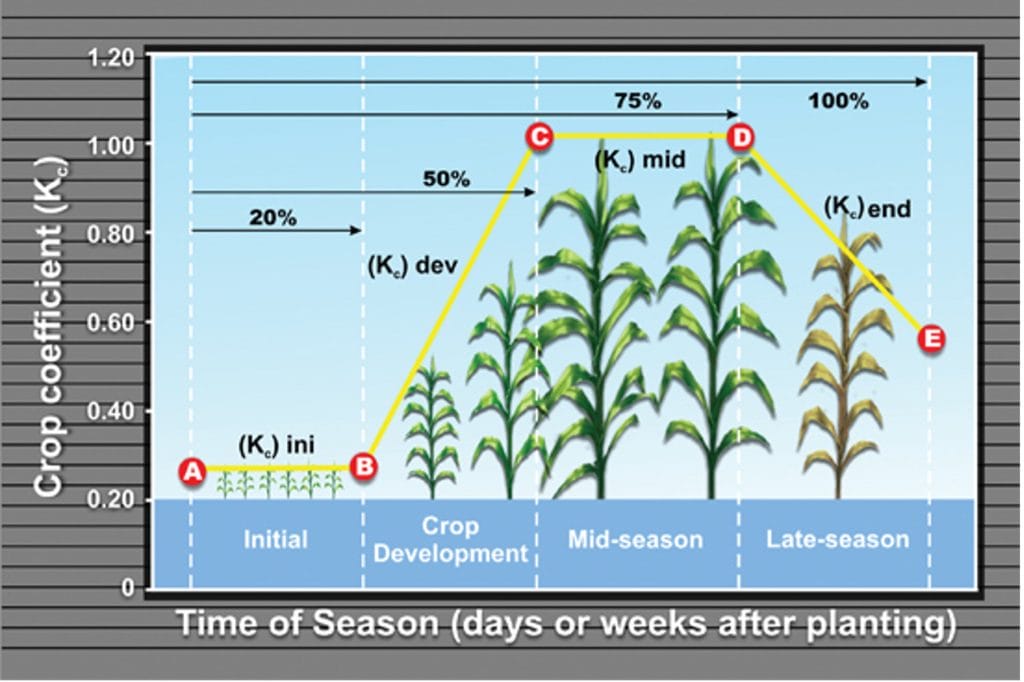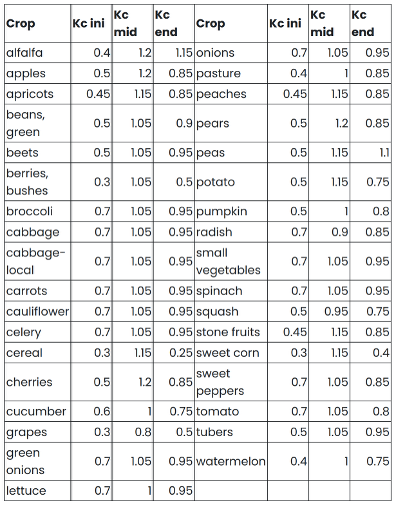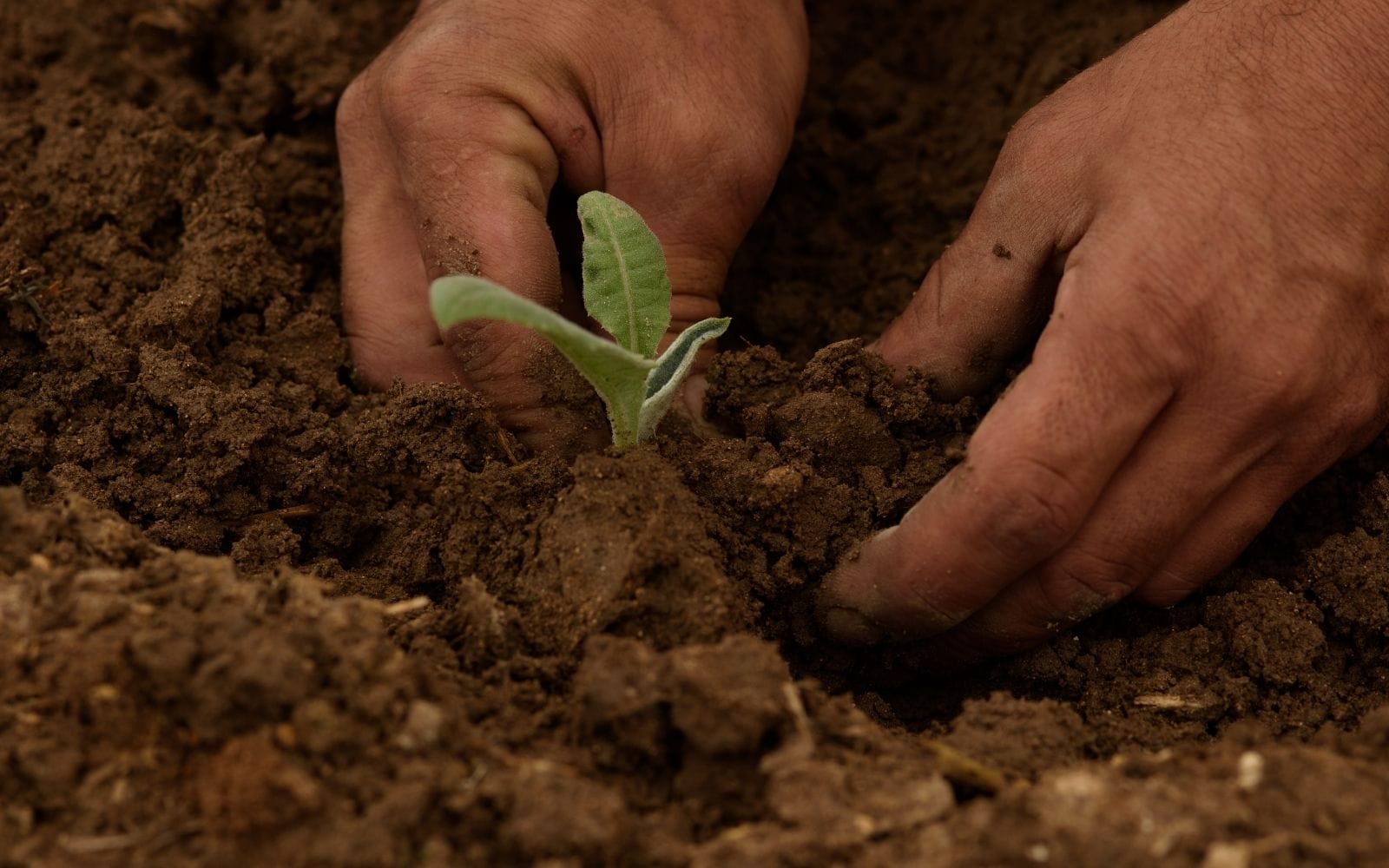September 2, 2025 at 4:15 pm | Updated September 2, 2025 at 4:15 pm | 6 min read
- To optimize irrigation without excessive water use, the actual water lost through crop evapotranspiration is replaced during watering.
- The crop coefficient provides information based on crop characteristics that can be used in models for indirect estimation of actual crop evapotranspiration.
- Crop coefficients are specific for crops, cultivars, regions, local climate, soil, and agricultural management practices.
To optimize irrigation, the water lost in the field is calculated based on the evapotranspiration of individual crops, ensuring the supply of only the necessary amount of water. The crop coefficient, a parameter used by farmers, irrigation managers, and engineers, is a key factor in determining irrigation needs. National agencies and researchers usually determine the values of crop coefficients. This article discusses the crop coefficient and the various factors involved in its calculation.
What is Crop Coefficient?
Crop coefficient (Kc) is the crop evapotranspiration (ETc) specific to each crop. It is widely used to calculate the water that must be added through irrigation to replenish water loss in fields.
Evapotranspiration (ET) has two components: transpiration by the crop plants and loss of water from the soil in which the crop is growing. During the initial phases of the crop, when there is less ground cover and more exposed soil, the evaporation component is higher; however, plant transpiration increases as the canopy grows during later stages. Direct measurements for evapotranspiration are expensive, which is why indirect methods, such as crop coefficients, are used for its estimation.
Subscribe to the CID Bio-Science Weekly article series.
By submitting this form, you are consenting to receive marketing emails from: . You can revoke your consent to receive emails at any time by using the SafeUnsubscribe® link, found at the bottom of every email. Emails are serviced by Constant Contact
Typically, average Kc values are calculated by research and are publicly available. Jensen proposed the concept of crop coefficient in 1968, which was further developed over the decades.
Variations in Crop Coefficient
The Kc values reflect changes in crop leaf area, height, canopy cover, canopy resistance, planting date, plant growth rate, leaf age, degree of stomatal control, soil water status, and conditions, as well as agricultural management practices and local climate. Hence, the crop coefficient varies by cultivar, growing stage, region, and regional climate.
Since crop coefficient is influenced by canopy structures, growth rates, and water use efficiencies, it varies among cultivars of a species. Moreover, it can vary depending on growing conditions, soil water status, and irrigation management. Therefore, a Kc for a single cultivar, such as maize, will vary in different parts of the world or under different farm management systems.
Crops with taller vegetative parts or those growing in drier weather will have a higher Kc, while smaller and shorter plants, as well as those growing in humid conditions, will have a lower Kc.
Typically, Kc ranges from 1.2 to 1.3, except for taller maize and wheat in arid regions, which have Kc values of 1.86 to 1.8, or 1.9 for biofuels.
Crop Coefficient Curve

Figure 1: “Crop coefficients (Kc) vary according to plant growth stage [(Kc)ini: crop coefficient for initial growth stage; (Kc)dev: coefficient for plant development stage; (Kc)mid: coefficient for mid-season; and (Kc)end: coefficient toward the end of the season],” Irmak (2009). (Image credits: https://extensionpubs.unl.edu/publication/g1994/2017/html/view)
As plants grow, their morphological (leaf area, canopy cover) and eco-physiological changes alter Kc. Therefore, Kc, which defines the crop’s contribution to evapotranspiration, will also change. The changes in Kc during the crop cycle are represented in the crop coefficient curve as a function of days or weeks. Four Kc values are used, covering the initial (Kc ini), plant development stage (Kc dev), mid-season (Kc mid), and end-of-season (Kc end) stages, as shown in Figure 1.
- The initial crop stage is characterized by the plant covering 10% of the soil, and the Kc is low and consistent.
- The development stage refers to crops that provide 70-80% of soil coverage for row crops and 60-70% coverage in trees. The Kc increases rapidly during this stage.
- Mid-season crops provide 100% soil coverage and occur when fruits or grains reach physiological maturity, and leaves start to yellow. The Kc values are highest in this phase for crops.
- Late-season crops are ready to harvest, and the Kc values start to decrease.
Types of Crop Coefficient
Crop coefficient (Kc) is valueless as it is the ratio of the actual crop evapotranspiration (ETc) to a reference crop’s evapotranspiration (ETo).
Or Kc =ETc/ ETo (equation 1)
Alfalfa or grass is used as the reference crop, whose evapotranspiration is measured and compared with that of the crop under study. The reference crop must be actively growing in well-watered conditions in the same climate where Kc will be used to predict irrigation. The reference evapotranspiration can be estimated directly or through an analytical and statistical method. The reference evapotranspiration is calculated on a daily or weekly basis.
Two types of crop coefficients are used in the calculation of evapotranspiration: the single and dual crop coefficients. Both crop coefficients assume there are no limitations on crop growth or evapotranspiration due to planting density and biotic and abiotic stresses.
Single crop coefficient: This Kc is used for general irrigation management purposes by farmers, managers, and engineers. It is the average of multiple days and is calculated through research; the values are publicly available. The single crop coefficient integrates the effect of both soil evaporation and plant transpiration under standard conditions. The Kc values for some common crops grown in British Columbia, Canada, are shown in Table 1.
Dual crop coefficient: This crop coefficient is used when precise estimates are required and irrigation schedules must be calculated daily. In this crop coefficient, soil evaporation and plant transpiration are measured separately through the soil evaporation coefficient (Ke) and the basal crop coefficient (Kcb), respectively. This coefficient involves complex calculations and requires the use of computers. The Kc is the sum of the two factors, as shown in Equation 2.
Kc = Kcb + Ke (equation 2)
- Soil evaporation coefficient, Ke, measures the evaporation component. When the soil is wet due to rain or irrigation, it is at its maximum, but it reduces to even zero when the soil becomes dry.
- The basal crop coefficient (Kcb) is the ratio of the actual crop evapotranspiration to the reference evapotranspiration (ETc/ETo) when the soil is dry and there is no evaporation. Still, transpiration occurs as water is not a limiting factor.
It has been found that the Kc curve is more accurate when factors influencing evapotranspiration, such as leaf area index (LAI), ground cover indices (GC), mulching practices, and growth in greenhouses, are also considered, in addition to the number of days alone.
Table 1: Single crop coefficient for some typical crops grown in British Columbia, Canada, Farmwest.com. (Credits: https://farmwest.com/climate/calculator-information/et/crop-coefficients/)

When growing conditions and local weather are similar, Kc is the same for fields in distant areas. For example, scientists report that the Kc value for tomato cultivars is the same in Italy and Chile.
Irrigation Management
Using researched Kc values, it is possible to calculate the actual evapotranspiration of a crop and fine-tune its irrigation management. Usually, the single Kc is used. The equation to calculate crop evapotranspiration ETc is as follows:
ETc = Kc ETo (equation 3)
Where Kc is the crop coefficient and ETo is the reference crop’s evapotranspiration.
An example from a University of Nebraska–Lincoln report is used to illustrate the application of the equation for irrigating a corn crop at the silking (or mid-phase) stage. If the corn Kc is 1.10 and the reference ETo in July is 1.20 inches, applying equation 3, show that the actual water used by the crop to replace evapotranspiration losses is
1.20 x 1.10 = 1.32 inches
If the efficiency of the irrigation apparatus is only 85%, more water should be added to compensate for water loss. In this case, the water needed is as follows:
1.32 inches ÷ 0.85 = 1.55 inches
Soil moisture should also be checked in the fields before irrigation. If the soil is wet, the crop coefficient should be lowered; if the soil is drier than usual, the Kc should be higher.
If the dual crop coefficient is used, the crop evapotranspiration is calculated by equation 4:
ETc = (Kcb + Ke) ETo (equation 4)
Plant Parameters for Kc Calculation
Most evapotranspiration studies use lysimeters. However, studies are also aiming to derive Kc or basal Kcb using plant parameters such as LAI, the ground covered by the canopy, the fraction of light intercepted, the fraction of photosynthetically active radiation (PAR), crop height, tree size, and vegetative indices like NDVI. Research institutions that estimate Kc require precise measurements of the plant parameters. CID Bio-Science Inc.’s CI-110 Plant Canopy Imager can estimate canopy cover, LAI, and PAR. Moreover, the CI-340 Handheld Photosynthesis System can directly measure transpiration in the field in real time.
Find out more about the two tools offered by CID Bio-Science for your crop coefficient measurements.
Sources
FAO. (n.d.). Chapter 6 – ETc – Single crop coefficient (Kc). Retrieved from https://www.fao.org/4/x0490e/x0490e0b.htm
FAO. (n.d.). Chapter 7 – ETc – Dual crop coefficient (Kc = Kcb + Ke). Retrieved from https://www.fao.org/4/x0490e/x0490e0c.htm
Farmwest.com. (n.d.). Crop Coefficients. Retrieved from https://farmwest.com/climate/calculator-information/et/crop-coefficients/
Kamble, B., Kilic, A., & Hubbard, K. Estimating Crop Coefficients Using Remote Sensing-Based Vegetation Index. Remote Sensing, 5(4), 1588-1602. https://doi.org/10.3390/rs5041588
Irmak, S. (2009). Estimating Crop Evapotranspiration from Reference Evapotranspiration and Crop Coefficients. Retrieved from https://extensionpubs.unl.edu/publication/g1994/2017/html/view
Lazzara, P., & Rana, G. (2010). The crop coefficient (Kc) values of the major crops grown under Mediterranean climate. Mediterranean Dialogue on Integrated Water Management, FP6 INCO-MED Funded Project.
Pereira, L., Paredes, P., Melton, F., Johnson, L., Wang, T., López-Urrea, R., Cancela, J., & Allen, R. (2020). Prediction of crop coefficients from fraction of ground cover and height. Background and validation using ground and remote sensing data. Agricultural Water Management, 241, 106197. https://doi.org/10.1016/j.agwat.2020.106197
(n.d.). Crop coefficient of 40 varieties. Retrieved from https://water.rid.go.th/hwm/cropwater/CWRdata/Kc/kc_en.pdf
Related Products
Most Popular Articles
- Transpiration in Plants: Its Importance and Applications
- Leaf Area – How & Why Measuring Leaf Area…
- How to Analyze Photosynthesis in Plants: Methods and Tools
- Plant Respiration: Its Importance and Applications
- The Forest Canopy: Structure, Roles & Measurement
- Stomatal Conductance: Functions, Measurement, and…
- Forest & Plant Canopy Analysis – Tools…
- Root Respiration: Importance and Applications
- The Importance of Leaf Area Index (LAI) in…
- Irrigating with Saline or Seawater






